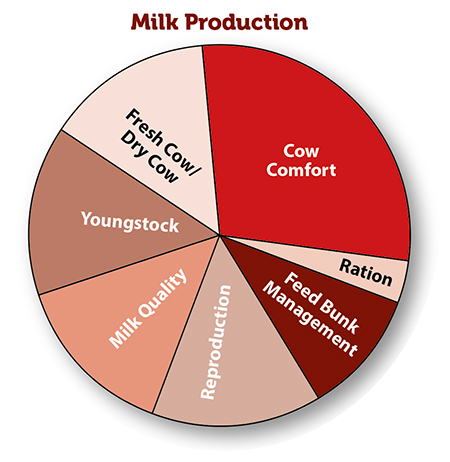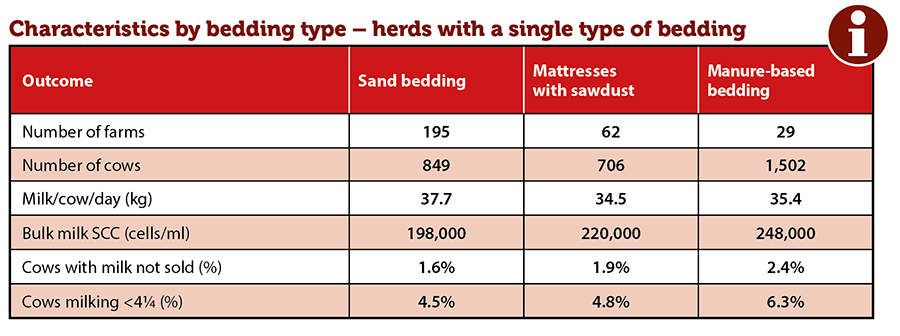Is cow comfort affecting your yields?
29th August 2024
Getting cattle housing right can improve both health and yields – Christopher Bailey, of Paragon Veterinary Group, provides a handy guide.

There are only three things a cow should be doing on a dairy farm – if she is not doing one of these things, she is not earning you money: Standing to milk, standing to eat and drink, or lying down.
To make sure your cows are doing one of these three things at all times, think of the ABCs:
Air quality and ventilation
Bunk management (ration formulated, mixed, and consumed; bunk design and space; feed quality
Cow comfort.
Yield can vary by 14kg (20–34kg) across herds with similar genetics, according to a study of 47 herds which were fed the same TMR mixed in a central location and sent to the farms (A Bach, 2008). Non-dietary factors accounted for 56% of this variation, including: stall design and management – stalls per cow (overcrowding); and feed management – feed for refusals (29kg vs. 27kg); and feed push-up (29kg vs. 25kg).
Importance of DM intake

Each extra kilogram of dry matter results in 2.5 litres of extra milk. If milk is sold for 40 pence per litre and feed costs are 20p per kg, getting cows to eat an extra 20p of feed should result in 2.5 more litres, resulting in £1 more milk revenue.
Cows should have fresh feed available at all times – they are crepuscular, meaning they are most active in the morning and at night. Cows can consume 35% of their daily intake in the first feed of the day. If they are averaging 35 litres per day, the highest yielding cows should be producing 70 litres.
If cows are achieving 26kg of dry matter intake and you are feeding 50% in the morning and 50% at night, cows are receiving 13kg at each feeding. A 70-litre cow requires an extra 14kg of feed (40kg in total). If she wants to eat 35% of her dry matter intake in the morning (14kg) but you are feeding only 50% of the diet in the morning, she will be 1kg short.
In large herds, deliver 60% of the feed when they exit the parlour. Smaller herds either feed at dawn, or if feeding at night ensure 60% of the feed is still available at dawn.
Cows should never be hungry when you put out fresh feed; ideally, they should not rush to the bunk. Avoid EMS (empty bunk syndrome); weigh back refused food, aiming for 1kg dry matter per cow.
Cow comfort and cubicle design
Cows should be in the cubicle house for 20 hours a day and should not spend more than four hours a day in collecting yards/milking parlours.
Lying times: There is a strong correlation between lying times and milk yield. Each extra hour of lying results in 1.7 litres more milk. Lying times are affected by cubicle design and bedding. Assess current stalls by examining cows for hock marks and neck rubs, which are signs of incorrectly designed stalls.
Ideally, 80% of cows should be lying down during the day. Every cow should have a cubicle and ideally the building would not be stocked more than 95%. Signs of incorrect cubicles or beds include cows standing half-in, half-out of cubicles, or standing while touching a cubicle. Recommendations for cubicle design are available on the AHDB website. Ensure cows have adequate open space in front to lunge into when getting up.
Bedding: The three functions of bedding are: to provide a cushion for the cow, absorb moisture to prevent bacterial growth, and prevent friction injuries to the hocks. Research suggests that deep-bedded sand beds are best for cow comfort and yield, reducing mastitis and increasing yields by almost three litres per cow. The issue with sand is the handling of it. If using a mattress and sawdust ensure lots of sawdust is used.

Feed and water access
To increase feed intake and milk production, provide 0.7m of feed bunk space per cow to ensure all cows can eat simultaneously. Fresh, clean water is also essential. Cows need 15cm of water trough space per cow.
Ideally, troughs should be spaced out around the shed to allow less dominant cows access to water. Troughs should be easy to empty, clean, and have sufficient volume or water pressure to ensure constant availability. Cows will drink 30% of their intake in the hour after milking.
Lighting
Good lighting is important for cow welfare, heat detection, and intake. Cows should have 16 hours of bright lighting (200 lux) and eight hours of darkness (less than 50 lux). Lights should be well spaced to prevent shadows, which can scare cows. Darkness can be achieved using red lights, allowing observation and work in the shed without disrupting cows’ rest cycles. Proper lighting can increase milk production by 6–15%.
By focusing on these areas, farmers can significantly improve cow comfort, health, and productivity, leading to better overall farm performance.
Read more livestock news
